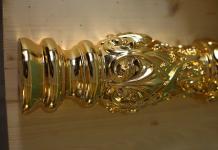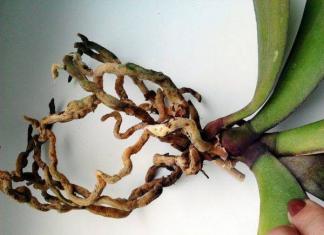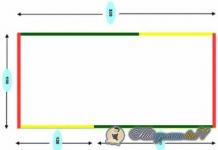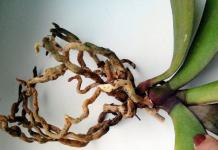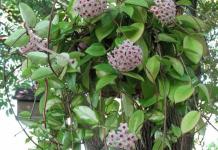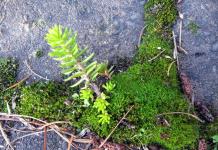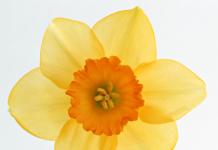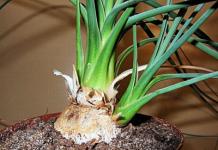Hi all! This material contains folk advice to the gardener and gardener. If you have original ideas and proven experience, share your research in the comments to this article. Let as many people as possible use your popular advice to gardeners and gardeners in their gardens and dachas! And so, let's go.
What you will learn from this material:
Horseradish sits in the “dungeon”
With great difficulty, I rid the garden of the spontaneously growing horseradish. But since I need horseradish leaves for marinades, I can’t do without this plant. I adapted to grow horseradish in old leaky buckets. I fill them with garden soil, flavored with organic matter, and plant 1-2 rhizomes. I water the plantings abundantly - excess moisture leaves through the holes in the buckets. I can’t say that horseradish rhizomes grow very large, but enough leaves are formed.
Having walled up horseradish in a bucket, I do not allow it to spread around the site. In addition, in a container it can be moved from place to place - in August I move it closer to the summer kitchen, where I prepare homemade pickles. Very comfortably!
Zucchini on the sand
The soil in my area is sandy, easy to work with. But it does not retain well and is not too rich in nutrients. Not all vegetables succeed on such a land. But for some I manage to provide suitable conditions, and they make me happy with the harvest.
For example, my zucchini grows well. Since the fall, I have been laying a thick layer of grass, leaves, sawdust, chopped vegetable scraps, and flower stems at the base of the bed. I pour hot infusion of ash over the planting, flavor it with a handful of superphosphate, and sprinkle 20 cm of soil on top. And I also make sure to add dolomite flour; sandy loam soils usually lack magnesium.
In the spring, without digging up the bed, I pierce it with a pitchfork, trying to loosen the deep layer. At a distance of 1 m from each other, I sow germinated zucchini seeds into the ground. I make such a large gap because the bushes grow powerful, with large leaves, sometimes for better ventilation I remove some of the leaves.
The laid “featherbed” not only supplies food, but also absorbs water well, creating a supply of moisture at depth. Even if the top layer of soil dries out, it doesn’t matter - the roots of zucchini find food in the depths. If the weather is rainy, then excess moisture is not retained in the upper sand layer, and decay does not occur.

Garlic - bushes!
Sometimes I plant garlic not only in a designated bed, but also where there is simply free space. I sometimes forget about this “free” garlic, and the heads remain overwintering in the ground. In the spring, a whole bush of vitamin greens grows in this place. One day I decided to experiment and specifically planted heads of garlic before winter rather than cloves. I placed them in the trunk circles of apple and pear trees, so that the garlic would also repel pests with its aroma.
What are the results? I didn’t grow large heads under the trees, but it seemed to me that there were fewer pests. And most importantly, in early spring I had plenty of delicious greens.

Beetroot visiting cabbage
Beetroot is an indispensable vegetable in our garden. One day it didn’t grow well, and in order not to be left without a harvest, my husband decided to sow literally a row of seeds in a bed with other vegetables. Here it was only necessary to take into account who is a friend of the beets and who is an enemy. We knew that this root crop would be uncomfortable next to potatoes, but in a cabbage, onion or garlic bed, a guest would certainly be welcome. It was there that the husband sowed beets.
The idea turned out to be successful. Root crops planted on garlic and cabbage beds grew large. And this is not surprising - pests did not “see” beets among other crops; there was no competition for food and a place in the sun for vegetables.
By mid-September, the beets had formed large, strong roots, and we got an excellent harvest.

To make the greenhouse serve for a long time
Many believe that a polycarbonate greenhouse is eternal, and are quite disappointed when it quickly fails. Yes, polycarbonate is a durable material, but it also needs care.
First, do not use aggressive chemicals for autumn disinfection. Never use sulfur-based smoke bombs for fumigation, although such recommendations are often found! For polycarbonate greenhouses, there are special smoke bombs with thiabendazole. Also, do not use hard scrapers to remove dirt, mold and algae. But you can use a steam generator - a jet of hot steam will carefully and effectively disinfect joints, corners and other hard-to-reach places.
In winter, regularly dump snow from the roof. A half-meter layer of snow with its weight can break not only the sheathing sheets, but also the racks. Do not scrape frozen snow. If it is not possible to come to the site in winter, then install an additional support frame inside the greenhouse.
The weather at the end of winter brings big problems to the greenhouse, when the sun shines brightly during the day and there is bitter frost at night. During the day, the air inside the greenhouse heats up, and the inner layer of polycarbonate gets warmer. And at night, the outside of the polycarbonate cools down greatly, resulting in thermal stresses in the sheet. If snow also presses on the roof, it may crack. Therefore, try to ventilate the greenhouse to equalize the temperature inside and outside. However, if you rarely visit the site, then it is better to close the door and vents tightly so that they are not swayed by the wind.

Mongolian onion - a garden friend
At the words "Mongolian bow" the imagination draws the weapons of the nomads, sending deadly arrows at the enemy. But the Mongolian bow is also a vegetable, the green arrows of which are among the first to pierce the spring snow and bring relief from spring beriberi.
This type of onion is wild, therefore it is distinguished by enviable vitality and accumulates a lot of biologically active substances. In nature, it grows in the foothills of Altai, Mongolia, and Buryatia. Outwardly, the plant looks like a batun onion: from medium-sized onions wintering in the ground, juicy hollow leaves grow in spring. In mid-summer, flower arrows appear with yellowish balls of inflorescences.
A resident of rocky slopes, the Mongolian onion prefers sandy or even gravel soil, does not like stagnant moisture. In a dry place, it is extremely winter-hardy, but in a flooded place it will almost certainly dry out or die from disease. So choose for him an elevated, well-lit place in the spring sun. I actually planted a bunch of onions on an alpine hill. In spring, bright greenery looks very elegant, and it doesn’t spoil the summer look of the flowerbed. But already in April I have fresh greens on the table.

Healthy potatoes until spring
Putting potatoes in storage, we hope that they will lie until the next harvest. But, alas! Often the potatoes begin to spoil. Over the years, I figured out the reasons and now I try to prevent spoilage of the crop, adhering to a few rules.
- 1. High-quality potatoes should be stored. If you see that the tubers are even slightly damaged, they should be removed. Before laying, I always dry the potatoes thoroughly and sort them, separating the damaged ones.
- 2. Consider the compatibility of vegetables. Many people store other vegetables along with potatoes. However, as my experience has shown, only beets are well stored with potatoes (I spread it on top of the tubers).
- 3. Store according to the variety. Well, if you have one variety, and you know what conditions it requires. But I, for example, grow several varieties of potatoes. In this case, vegetables of different ripening periods should not be mixed, since early varieties are stored less than late ones.
- 4. Sort during storage. If the potatoes still began to deteriorate, sort it out, removing the damaged tubers. Moreover, if a rotten tuber is found, remove those that lie nearby - they are probably also spoiled.

Decorates and bears fruit
I have long wanted to plant a beautiful fruit-bearing vine in the courtyard of a country house. Neighbors advised a plant - actinidia kolomikta. This is a rather unpretentious, frost-resistant plant that blooms spectacularly and gives delicious.
Planted seedlings in autumn from the sunny side of the gazebo. I made landing holes at a distance of 1.5 m from each other, with a diameter and depth of 60-70 cm. At the bottom of each I put drainage from broken bricks. I added humus to the holes - about a fifth of the total volume of soil removed from the hole. Landings were abundantly watered with warm water and mulched with straw.
In the spring, seedlings actively began to grow. Now at the beginning of each summer I feed actinidia with a solution of horse manure, water it regularly and loosen it shallowly 2-3 times a season - the roots of the plants are close to the surface of the earth.
Care is simple, and the benefits of actinidia are significant. And its fruits are delicious, and it looks beautiful on the gazebo. I especially like this plant in the fall, when the leaves turn reddish.

Raspberries - autumn feeding
Every autumn, when it is already noticeably colder, I feed raspberries. It is important to wait until it gets cold because in warm weather, fertilizing can provoke rapid growth, and on the eve of winter this will be detrimental to the plants. Previously, I used only organic matter for fertilizing. But the farm where I got it closed, and I had to switch to mineral water.
To prepare top dressing, I mix potassium salt and superphosphate in a 1: 1 ratio. Then I make deep grooves around the bushes - 30-40 cm from the stems - and put fertilizer there. For 1 sq. m of raspberry bush I use about 40 g of mixture. Then I fill the grooves. Next up is the autumn rains. They dissolve fertilizers and nutrients flow to the roots of plants.
Judging by the yields I get, raspberries like both organic and mineral fertilizers.

Shrubs: work on bugs
Often berry bushes are planted in the shade. But plants without sun weaken, stretch out and practically do not lay fruit buds. The result is a low yield.
Another common mistake gardeners make is that they do not use manure for fertilizing. And for normal growth, shrubs need manure, and in large quantities. It is necessary to lay out a half-spadeful layer of manure in the tree trunk circle, and also add leaf humus.
You can also add dried, weeded weeds (without seeds!) and sawdust on top - thanks to this mulch, the soil will become looser and moisture will evaporate less. To maintain a high layer of mulch, it is convenient to use borders (they can be made from any available material).
Some gardeners mistakenly believe that shrubs can grow without pruning. In fact, in this case, the bush is formed more slowly, and the berries are smaller. Pruning should be done both in the spring, before the buds open, and in the fall, after the leaves fall. Its main goal is to form a healthy and well-lit bush.
We can not forget about the pests. But now a lot of means of dealing with them are being offered, so I think it will not be difficult to find the right one.
"Coffee" for trees
In autumn, gardeners use granular potassium-phosphorus fertilizers to feed trees. I treat my garden not with “sweets” - granules, but with nutritious “coffee”. I grind fertilizer in an old coffee grinder. In the near-trunk circle of each tree I make indentations (30-35 cm).
If the tree is mature, then you need to make 20 holes, and if it is young, 10 is enough. Then I put a pinch of fertilizer into each recess and pour it with water - I brew “coffee”.
Usually, potassium-phosphorus fertilizers are recommended to be applied in the fall, but with such a late application, there is a high probability that a significant part of the nutrients will be washed out by rains. Therefore, I fertilize in July-August so that my trees have time to get food and lay fruit buds.

Crimson hawthorn
Blood red hawthorn has been growing for me for many years. In June, beautiful white double flowers appear on the tree, and then large fruits form. When they ripen, they turn bright red. Hawthorn fruits are juicy, healthy and very tasty.
The plant is undemanding to soil, but it must be planted in a bright place. This can be done both in spring and autumn. When planting, the hole should be large enough, 50-60 cm deep. Add 5 tbsp to it. l. nitrophoska. After planting, water.
From the 2nd year until the start of fruiting (it usually occurs in the 5th year), you need to feed the hawthorn twice a season. In spring - urea (2 tablespoons per 10 liters of water), 10-15 liters per tree. In autumn - nitrophoska (in the same proportions).
Instead of a seedling - a “stick”?
Self-rooted cherries, plums, cherry plums, and damsons can be propagated by root shoots.
However, when trying to transplant a sprout, it often turns out that it has almost no small roots of its own. This happens especially often with shoots near the mother tree. Having cut the main root, we remove the “stick” from the ground. The survival rate of such a seedling is not great.
The quality of shoots taken 2-3 m from the mother tree is somewhat better. There are usually more of their own roots, but still much less than those of seedlings or rooted cuttings.
In order for such a seedling to be of high quality, you need to take care in advance of the formation of its own roots. We choose a sprout away from the trunk. In early spring, we scrape away the soil from it and the main root, forming a groove 20 cm deep.
We fill it with humus and feed it with superphosphate several times in the summer. In mid-summer, cut the main root halfway on both sides, 15 cm from the sprout (to stimulate root formation). In winter, cover the soil around the sprout with a thick layer of leaf litter or peat. And in early spring, before the buds open, we separate the shoot and transplant it to a new place.
The scientific and production association “Gardens of Russia” has been introducing the latest achievements in the selection of vegetable, fruit, berry and ornamental crops into the widespread practice of amateur gardening for 30 years. The association uses the most modern technologies and has created a unique laboratory for microclonal propagation of plants.
The main task of the NPO "Gardens of Russia" is to provide gardeners with high-quality planting material for popular varieties of various garden plants and new world selections. Delivery of planting material (seeds, bulbs, seedlings) is carried out by Russian Post.
We are waiting for you for shopping at the NGO "Gardens of Russia".
Tomatoes with grapes (WITHOUT VINEGAR!) Put "Class!" to save it on your page. For a 3 liter jar: sweet pepper - 1-2 pcs. spices and herbs that you use for regular pickling. Place spices, tomatoes, peppers and grapes between them (preferably light ones), disassembling them into small tassels of several berries. Pour in boiling water for 20 minutes. Boil the drained water, add 2 tablespoons of sugar and 1 tablespoon of salt and pour into a jar. Roll up. You can wrap it up.
Comments 3
Classes 177
When to sow petunia for seedlings. Floriculture for many is not just a hobby, but the meaning of life. The market is now replete with a variety of seeds and seedlings of flowers familiar to us and new ones, alluring with their exotic appearance. Flowers surround us everywhere - in neighboring front gardens, vegetable gardens, in city flower beds, in pots hanging from balconies. Nothing prevents you from creating beauty on your site. Read more: When to sow petunias for seedlings https://sovety-ogorodniku.ru/kogda-seyat-petuniyu-na-rassadu.html
1 comments
Classes 16
BORIC ACID IN THE GARDEN AND GARDEN Such a substance as boron is necessary for plants in order to supply the root system with oxygen as much as possible. Its absence significantly reduces the level of calcium intake to the plant organs. In order to always have a blooming, beautiful garden, and a generous harvest in the garden, in the arsenal of any gardener and gardener there is one necessary remedy containing boron. The use of boric acid in the garden. Thanks to top dressing, which includes boric acid, plants become more resistant not only to diseases, but also to adverse weather conditions. Experts note that thanks to boric acid, the yield increases by an average of 20%, or even 25%. Especially, such high rates are found in cucumbers, tomatoes, and cabbage. Seeds are treated with boric acid before planting - they are soaked for 12-24 hours (0.2 g of boric acid is diluted in a liter of water). Boric acid is applied directly to the soil before planting seedlings or seeds (2 g per 10 liters of water). Boric acid is sprayed on the leaves (5 g per 10 liters). In addition to pure boric acid, ready-made fertilizers such as boron superphosphate are also used: granular or double. Immediately before sowing, it is advisable to soak the seeds for a while in a solution with boric acid. By doing this you can speed up the germination process of your seeds. Usually the seeds of vegetables such as onions, tomatoes, carrots or beets need to be soaked for a day. But, for example, zucchini, cucumbers, cabbage - as little as possible, twelve hours will be enough for them. For the main application of microfertilizers to the soil, before planting seedlings or germinated seeds of flowers, fruit or berry crops, dilute two grams of boric acid in ten liters of water and water the earth abundantly with the following calculation: diluted composition per ten square meters. The use of boric acid for flowers had a very good effect. It needs to be added to the soil with a lot of peat, because it is too poor in boron content. Flowers such as violets need this. Boron helps speed up the absorption of calcium and abundant formation of buds. For foliar feeding, use a 0.1% solution of boric acid (10 g per 10 l). When foliar top dressing with boron, together with other microfertilizers, the concentration of boric acid is reduced by 2 times (0.5 g per 1 liter). The solution is sprayed on plants in the budding and flowering phase. Roses. Very good results are obtained by spring spraying with a solution of boric acid in a proportion of 10 g per 10 liters. To prevent fungal diseases, rose cuttings are immersed for 2-3 minutes. into a solution of boric acid (20 g per 10 liters of water). Gladioli. A solution of boric acid (2 g per 10 liters of water) is used to feed gladioli in the phase of 3-4 leaves and during the flowering period to obtain larger corms. Dahlias. Spraying with boric acid mixed with potassium permanganate (5 g + 2 g per 10 liters of water) has a beneficial effect on the development and flowering of plants. Fertilizing is done 2-3 times before mass flowering in the evening with an interval of 15-20 days. It was also noticed that boric acid had a very good effect on roses, and their resistance to fungal diseases increased. Boric acid in the garden is practically one of the best remedies today. Root feeding. Boric acid solution: 0.1-0.2 g of boric acid per 1 liter of water. It is used only in cases of severe starvation or a clearly known lack of boron in the soil. Plants are pre-watered with plain water to avoid chemical burns to the roots. Usually used on seedlings of flowering plants growing on soddy-podzolic soils or in a mixture of peat and sand. Good to know Boric acid dissolves easily only in hot water! Always first dilute the sample (bag) in 1 liter of hot water, then bring it to the required volume with water at room temperature. Strawberries: signs of boron deficiency: leaf bending and necrosis of the edges. Fertilizing with boric acid significantly increases the yield and improves the taste of the berries. In early spring, plantings are watered with a solution of boric acid with the addition of potassium permanganate (1 g potassium permanganate, 1 g boric acid per 10 liters of water), consumption - approximately 10 liters per 30-40 bushes. It is useful to carry out foliar feeding with a solution of boric acid (5 g per 10 liters of water). Before flowering, when the plants have put out their buds, apply foliar feeding with a solution (2 g of boric acid, 2 g of manganese, 1 cup of sifted ash per 10 liters of water). Make an extract from the ash in advance: pour a glass of ash with a liter of boiling water and leave, stirring occasionally, for a day, then strain through cheesecloth - and the infusion is ready. Tomatoes: signs of boron deficiency Blackening and death of the growth point of the stem, rapid growth of new shoots from the root, while the petioles of young leaves become very brittle. Brown spots of dead tissue form on the fruits, usually in the tip area. As a preventive measure, soaking seeds in a solution of boric acid (0.2 g of the drug per 1 liter of water) for a day or in a solution of microfertilizers containing boron helps well. Before planting seedlings, apply boric acid or boron-containing fertilizers to the soil (optional on cultivated soils). Do not forget about foliar feeding before flowering (10 g of boric acid per 10 liters of water). You can use foliar feeding of the same concentration in the green fruit phase to accelerate the ripening and accumulation of sugars in the fruits. Grapes Signs of boron deficiency: the appearance of chlorotic spots between the veins of leaf blades, which gradually grow, the absence of normal ovaries on the clusters (humming). A new seedling dies within a year or 1-2 years after planting in a permanent place. Even a single treatment during the budding period increases the yield by more than 20% due to the preservation of flowers and less shedding of ovaries. Taking into account the characteristics of the grapes, add zinc salts to boric acid (10 liters of water, 5 g of boric acid, 5 g of zinc sulfate). If the fruits of zucchini or zucchini rot, if the tomatoes in the greenhouse are stressed from the heat, if the fruits of peppers and eggplants do not set, if there are few ovaries on cucumbers, make a solution of boric acid and spray the plants.
Comments 0
Classes 58
WHY DO TOMATOES NEED FOOD SALT? Save it so you don’t lose it! Experienced gardeners successfully use ordinary table salt as a top dressing for some vegetables. The spread of this substance is facilitated by its environmental friendliness and cost-effectiveness. This unusual fertilizer is especially useful for tomatoes. When used correctly, irrigation with a saline solution makes tomatoes sweeter and protects plants from diseases and pest attacks. Benefits of Table Salt for Plants Regular table salt is also known by other names. It is also called stone, food or table. The main part of this product is sodium chloride or NaCl. This substance is white in color and resembles sand. Most often, salt is used in cooking to improve the taste of dishes, and also as an environmentally friendly preservative, which makes the shelf life of products longer. In the chemical industry, table salt is used to produce hydrochloric acid and baking soda. In relation to plants, rock salt has the following positive effects: protects against harmful insects; reduces the period of setting and ripening of fruits; as a top dressing for vegetable crops improves the taste of fruits. Important! The benefits of rock salt for plants are observed only when used in moderation. The abuse of such fertilizer causes the death of plants. Methods of application when growing tomatoes Fertilizers based on sodium chloride are prepared according to different recipes. Treatment of plants is carried out early in the morning or in the evening, when there is no active sun. Then the foliage of tomato bushes will be protected from burns. To improve the “stickiness” of the product, a small amount of liquid soap is added to it. Such treatments are useful for combating late blight. The salt solution, due to its specific taste, repels harmful insects. This property is used to protect plants from their attack. After irrigation with this product, a thin layer of salty dust remains on the foliage, which does not allow fungal spores to develop. It is more convenient to treat the bushes by spraying with a spray gun. Before use, it is recommended to pass the prepared solution through a filter to get rid of undissolved particles. Before treating bushes infected with late blight, all damaged parts of the plant are torn off. Foliage is processed from the top and bottom side. To improve the taste of tomatoes, during the ripening of the crop, 500 ml of the prepared preparation is poured under each bush. This feeding is carried out only for adult plants, with 6 or more formed leaves, once every 3-4 weeks. Recipes for products with table salt Various products are prepared from salt and water depending on their purpose. Sometimes additional components are introduced. As a top dressing during the formation and ripening of fruits, prepare a solution consisting of 10 liters of water heated to +25 degrees, 200 ml of wood ash and 1 tbsp. l. rock salt. After thorough mixing, the prepared product is used to water the plants every week. To make the tomatoes sweeter and more tasty, they are watered every 10 days with a solution consisting of 10 liters of warm water and 1 tbsp. l. table salt. To prevent infection or cure late blight of plants that has already begun, use a concentrated solution. To prepare it, add 1 glass of sodium chloride to 10 liters of water. Such spraying is carried out once every 30 days. To improve the effect of the spray solution, add a little soap in liquid form. Instead of a liquid product, you can add laundry soap shavings and dissolve them in the liquid. The positive effect of salt solutions for tomatoes is as follows: the taste of ripened tomatoes improves, they become more sugary; plants are protected from fungal diseases; pests do not damage bushes. If fertilizing is used incorrectly, the following negative consequences are possible: the acidity of the soil increases, favorable conditions arise for the development of the root beetle; the balance of nutrients in the soil and in the plant itself is disrupted. Important! Exceeding the permissible dose of sodium chloride causes crop loss. Salt solutions as fertilizer in beds with tomatoes will fully show their effectiveness only if used correctly. The concentration of the active substance should be low. Treatments should be carried out no more than once every 7 days. This type of fertilizer should not be used unless absolutely necessary.
Comments 4
Classes 123
THE GROWTH IS GREATER AND THE HARVEST IS SMALLER: THE GOSEBERRY Somehow I happened to witness a dialogue between two summer residents. “I have such gorgeous bushes on my berry plantation,” one boasted. - Not just bushes, but a whole grove! But they don’t produce enough berries. The varieties are, perhaps, bad.” “Most likely,” her “colleague” agreed. “I have the same story - they grow beautifully, but the harvest is nothing.” And you can hear thousands of such stories. However, the point here is not at all about the varieties. Although there are, of course, not very productive specimens, but not to the same extent that “one zilch”. The problem is different - the plants are not cared for properly. Therefore, let's decompose this problem point by point and determine how to fix the situation. 1. Thin out the bush. Gooseberry is a light-loving plant. He also loves to grow. As a result, he creates a problem for himself - some branches obscure others, and the harvest drops sharply. Therefore, this year it is important to cut off everything unnecessary from the old plant. To begin with, shoots are removed that practically lie on the ground, broken, intertwined, very thin and diseased. The tops of the remaining stems are cut off to the first strong side branch. This is done before the buds open. In the summer, immediately after harvesting, a second pruning is carried out - old branches are removed, on which there were either no berries at all, or very few. Of the shoots that have grown at the base of the bush, 4–5 of the strongest are left, and the rest are cut out so that the plant does not thicken. The ends affected by powdery mildew are cut off to a healthy bud. And for the future. Every summer, in late July - early August, it is necessary to pinch annual growths. This simple operation significantly increases the yield, and the berries become larger! 2. Feed him. Gooseberry is masculine and, like any man, he loves to eat well. During the summer he needs to be fed 5 times. The first - as soon as the leaves begin to bloom: 1 tbsp. spoon of urea and 2 tbsp. spoons of nitrophoska per 10 liters of water. The norm is 2 buckets per bush. The second - at the very beginning of flowering: 1 tbsp. spoon of potassium sulfate per 10 liters of water. The norm is 3 buckets per bush. But before pouring gooseberries with this fertilizer, 1–1.5 cups of ash should be evenly scattered under it. The third - when berries are tied: 1 tbsp. spoon of nitrophoska and 2 tbsp. tablespoons of potassium humate per 10 liters of water. The norm is 3 buckets per bush. Fourth - at the end of September - beginning of October: 1.5 tbsp. spoons of double superphosphate and 4 tbsp. spoons of potassium sulfate. These fertilizers are mixed, evenly scattered under the bush and watered. Fifth - at the end of October: 0.5 buckets of rotted manure under a bush. 3. Give him something to drink. Gooseberries are drought-resistant; they only need two waterings per season: at the end of May and the end of June. 4. And move neighbors in. Many gooseberry varieties are partially self-fertile. That is, by themselves they set about half of the possible number of berries. But if you plant other varieties, at least a couple more, then the yield doubles!
17 HOUSEHOLD Tricks That Will Make Life Easier! And cleaning is more enjoyable! 1. Unpleasant smells in the toilet Pour a little scented detergent into the brush holder to eliminate unpleasant smells in the toilet forever. 2. Plaque and rust on cutlery Rust and dark deposits on cutlery can be treated with lemon juice. Carefully treat spoons, knives and forks with half a lemon, leave for a while, and then rinse with running water and wipe with a clean woolen cloth. 3. "Noisy" drawers If you are annoyed by the loud sound that drawers make when closing, try applying a thin bead of hot glue to the top of the inside wall of the cabinet. 4. All-Purpose Cleaner A mixture of table vinegar and dishwashing liquid is a miracle product that will help you deal with almost any type of dirt in your home. This emulsion will allow you to save a lot on the purchase of special household chemicals. 5. Clean windows Cleaning windows is a difficult and unpleasant task. It can easily cope with complex stains, and water with starch will help to avoid streaks. Dilute a tablespoon of starch in one liter of water and wipe the surface of the window with the resulting emulsion. Rinse off dirt and starch with a damp cloth and wipe dry. 6. Dust on varnished surfaces Never wipe polished and varnished furniture with a wet cloth. To effectively combat stains on such surfaces, use only dry flannel, cloth or special wipes. 7. Anti-fogging agent A mixture of glycerin and alcohol is perhaps the most effective anti-fogging agent for glass. In addition, such an emulsion will help the windows stay clean for a longer time. This recipe is especially relevant on the eve of cold weather and the beginning of the heating season. 8. Caring for kitchen towels To ensure that kitchen towels wash better, soak them in warm water and vinegar before machine washing. 9. Shiny handles Don't forget the doorknobs as you tidy up. A lot of bacteria settle on them, and stains and fingerprints are obvious and spoil the appearance of the room. So, at least once a week, wipe the handles of doors and cabinets with special wipes or an alcohol solution. 10. Cleaning upholstered furniture Upholstered furniture, like a sponge, absorbs dirt and unpleasant odors. Pour a little vodka into a spray bottle, spray the surface of the sofa with the liquid and let it dry. Such a trick will help refresh the furniture and eliminate unwanted odors. 11. Carpet cleaning Carpets create an atmosphere of warmth and comfort in a room. However, in order for the carpet to last a long time and not lose its attractiveness, it requires proper care. Regular baking soda will help clean dirt and eliminate odors. Sprinkle it over the surface of the carpet, leave it for several hours, and then vacuum thoroughly. 12. Shiny plumbing Do not rush to throw away an unnecessary piece of lemon. It can be used to clean chrome bathroom fixtures. Run a slice of lemon over the surfaces of your faucets, showerheads and hoses to make them sparkling clean, like new. 13. Shiny mirrors Take half a raw potato, walk it over the surface of the mirror, rinse with cool water and wipe dry. This is the easiest and most affordable way to clean dirt and restore shine to all mirrors in the house. 14. The process of boiling potatoes To make the potatoes cook faster, add a little butter to the pan. 15. Drying shoes Salt will help dry wet shoes. Heat table salt in a frying pan, pour it into a sock and place it in your shoes. Repeat if necessary. This trick will be a real salvation on rainy autumn days. 16. Grate the cheese When starting to grate hard cheese, grease the grater with vegetable oil. The cheese will not stick together, and the grater will wash off much better. 17. Unpleasant odors in the kitchen The kitchen is always an abundance of aromas and not always pleasant ones. A tablespoon of vinegar will help quickly get rid of odors in the kitchen. Heat the vinegar in a frying pan until it evaporates completely.
In order not to attract a carrot fly when thinning carrots, you need to take a bucket of water and dilute 1 tbsp. l. ground red or black pepper (enough for 10 sq. m). There is no need to insist, just spray the carrots with infusion before thinning.
If you want to get a crop of good clean carrots (without any rot, infection, etc.), I advise you to definitely pour young plants with water (in a bucket) after the second thinning in early July with potassium permanganate diluted in it (3 g) and 2 - 3 g of boric acids. A bucket is enough for 3 - 4 square meters. m. Repeat the same procedure a second time in 20 days. The carrot will be clean. Just remember to water the carrots with plain water before watering with the solution.
To prevent carrots from becoming horned or cracking, thin them out, leaving a distance of at least 4 - 5 cm between plants.

Beet salt
Beetroot is an unpretentious culture, but a few tips can be given. Many gardeners do not like large beets. If you want to get a smaller vegetable, do not plant plants at a distance of 8 - 10 cm in rows and 18 - 20 cm between rows as usual, but reduce the distance between rows to 10 - 12 cm. By the way, I do not support sowing beets directly into the ground, I plant it only through seedlings (I grow it in a greenhouse).
When I plant seedlings in the ground (June 5-6), I make sure to pinch them back by a third or a quarter. Thus, the forces of the plant go to the “head”, and not to the root.
Beets, unlike carrots, love ash. Therefore, a couple of times during the season, add ashes under the beets. This helps neutralize the soil, because beets do not tolerate acidic soils well. You can even sprinkle lime under the plants to deoxidize them.
To make beets sweet, pour salt water on them twice (a spoonful of salt per bucket of water). Carry out the first watering when the root crop just begins to round, then 25 - 30 days before harvesting.

Tap the tomatoes
Tomatoes are one of my favorite crops. I have been growing the same proven varieties in a greenhouse for two decades now - “Titan” and “Peremoga”. What advice do I give to gardeners these days? The greenhouse already has the first tier with tomatoes. So, be sure to tear off the leaf on the tomatoes before this first tier so that it does not take away nutrition from the fruit. You need to pick the leaf as soon as small cherry-sized tomatoes appear; you don’t need to do this before: otherwise the ovaries will not set well.
These days you need to feed the tomato well with sodium humate - 10 g per 100 liters of water. Don't be afraid of sodium humate, it's an organic fertilizer.
In greenhouses, tomatoes set worse, especially in this hot summer. To speed up pollination, I advise you to tap the tomato stems, as I say tap.
Very often, gardeners do not know which shoots to pick off and which to leave, but this is directly related to the harvest. I advise you to remember: you need to leave only the first stepchild that appears under (and not above) the first brush. Most gardeners do just the opposite and leave the top, harmful stepson, which will bloom but not bear fruit. The remaining two trunks will allow you to form a bush (I sometimes form 3 stems) with 4 - 5 tiers of tomatoes.
I also want to dwell on one important detail: watering. Remember: you need to water tomatoes not under the bush, but between the rows. I water the tomatoes under the bush while they are small, and by June 10-12, when the bushes are completely hilled, I water abundantly only between the rows. Tomatoes like infrequent, but abundant watering (once every 7 - 8 days). Moreover, the top of the hillock should remain dry - this way air flows through the dry soil to the roots. You can even mulch the top with chopped straw. And let the moisture flow to the roots from the spaces between the rows. I will explain why: when we water a bush under the root, the water washes the root and the earth lags behind it. The root system again has to work, expend energy to "suck" the soil. In the grooves, wet soil, on the contrary, puts pressure on the roots and presses down the earth.

Arrow feather
Many gardeners complain that daikon or black radish shoots quickly. This can be avoided if you plant black radish no earlier than July 5-10, and daikon no earlier than July 25.
HOW TO GET A BIG HARVEST!
- It is important to plant and prune plants correctly. Bushes are planted with row spacing of at least 1.8 m and at a distance of 0.7 m in the row. Not one, but two seedlings are placed in each hole. Pillars are installed along the row and galvanized wire 4 mm thick is pulled at a height of 1.2 m from the ground.
Shoots are tied to it annually so that there are 7 shoots in the space between the bushes (0.7 m). Poles, wire, raspberry plants together make up what we usually call a trellis. With this arrangement of plants, each bush takes up little space and is well lit by the sun.
- Every year, from 5 to 10 replacement shoots grow from the base of the bush, in addition, around the bush, the same number of shoots rise from the roots. After wintering, they are inspected. Broken and thin ones (with a diameter smaller than a pencil) are cut out without leaving a stump, so that the bush still has only 7 shoots.
All shoots are removed in the summer in May-June, that is, immediately after emergence. This way, all the nutrients and moisture will go to the main bush. Many gardeners, unfortunately, do not remove shoots in a timely manner, which leads to a decrease not only in a significant part of the harvest, but also in the quality of the berries.
- Every year in the fall, 3-4 buckets of humus are brought under each bush, if it is not there, then 3-4 buckets of peat mixed with 100 g of urea or saltpeter. Please note that the use of nitrogen mineral fertilizers in the spring causes the active growth of coppice shoots and does little for the development of replacement shoots. If you notice a weak growth of shoots, then at the end of May, give each bush a top dressing: a shovel of fresh mullein and a matchbox of urea or saltpeter for a bucket of water. These fertilizers are sufficient for the entire growing season.
- Loosening the soil. Raspberry roots are rather superficial, so the soil is only cultivated to a depth of 5-10 cm and always after fertilization.
- It is important to do autumn (moisture-charging) watering (if the autumn rains in October - early November did not do it for us). To do this, the raspberry plant is simply filled with water. Summer watering is only needed if the soil dries out. Raspberries do not grow in swamps; they do not tolerate waterlogging or places with stagnant water. However, without enough moisture it takes on a sickly appearance.
- Protection from various pests and diseases. The main thing in this matter is healthy planting material. Fungal and viral diseases on raspberries are very common, but there is no fight against them in any country in the world. True, plants are treated with insecticides, but according to a minimal scheme, carefully observing the time and frequency of spraying. Insecticides often have to be used against the raspberry beetle (“wormy berries”) and sometimes at the end of summer against the raspberry mosquito.
- Large-fruited varieties do not require any additional care, except for the obligatory bending of the branches for the winter so that they lie under the snow, then frosts below -30 ° C do not damage them. The advantages of large-fruited raspberry varieties are that their berries weigh 4-12 g, and not 2-3 g like regular varieties; Each fruit branch can ripen up to 40-45 or more berries instead of 8-14.
Gardeners and gardeners are the most savvy people. They need to know and be able to do literally everything. How to grow excellent seedlings, transfer them to open ground in time, how to plant plants nearby that not only will not interfere with each other, but will also create optimal conditions for growth and development. And besides this, you need to create an attractive image of your site, that is, master landscape design skills. Today we will look at some gardening tricks that will be useful to each of you.
Relevance of the issue
If you start gardening, you will find that there are many things that become stumbling blocks on the path to success. Seemingly simple things, but to master them you have to spend several years. But this is only if the gardener is guided only by his own experience. But gardening tricks are passed on from one to another, and this store of knowledge only grows. Therefore, the topic will never lose its relevance.
So that the garden smells fragrant
The first step is to achieve a good harvest. Of course, for many lovers, their garden is also a place of relaxation. But you still want to stock your pantry with your own fruits and vegetables in the fall. Therefore, let's look at gardening tricks that will greatly help a beginner and an experienced summer resident.
- The sooner spring comes to your garden, the greater the chances of growing a good harvest. It is quite simple to bring its onset closer by 7-10 days. It is enough to blacken the snow with ash when sunny days arrive.
- If fruit trees bloom too early, they may suffer from frost. To prevent this from happening, the ground underneath is covered with a thick layer of snow, and the top is covered with light mulch. The ground under the crown remains frozen longer and flowering is delayed by about a week.
- As soon as the leaves begin to bloom, your fruit trees become the object of close attention to various pests. To protect the garden, you need to install catch belts. This is burlap tied around the trunks. Pests will hide in them, where the gardener will collect them.

- We attract beneficial insects. This is another gardening trick. If your fruit bushes and trees are blooming profusely, but most of the flowers are falling off without setting, there may be few bees visiting your garden. Try making honey baits or simply spraying flowering bushes with honey water.
- This method will not help if the ovary falls off due to poor soil or lack of sufficient watering.
Pest control and more
It is not enough to plant a good variety, select the right fertilizers and ensure timely watering. It is necessary that your harvest is not attacked by pests and that it is not destroyed by diseases. This is exactly why gardening tricks will come in handy. Gardeners' advice for the garden will be relevant at all times, so take a pen and write down:
- Keep a few spray bottles on hand. Fill one with white vinegar. This will help get rid of weeds that like to peek out of cracks in concrete paths. At the same time, this remedy works well against ants.
- In order to get rid of pests, you can prepare the following composition. Take a few cloves of garlic and grind them into a paste. Add 50 ml of oil, three tablespoons of hot pepper sauce and half a teaspoon of liquid soap. Dissolve in 2 liters of water. This is an excellent insecticide.

Everything you need to know!
This can become the motto of every summer resident. On the site you have to do a lot with your own hands. Garden tricks allow you to get around the pitfalls and make the job easier and the results more impressive. Let's look at a number of proven manipulations that you can master too.
- How to quickly drive a stake into the ground. At first glance, this is a difficult task. But sometimes this is required to build a greenhouse. Just sharpen it and stick it into the ground with your hands. After that, pull it out and pour water into the hole. Repeat the procedure several times - and the stake will firmly enter the ground.
- The use of ash as a top dressing. This is a valuable fertilizer, but in itself it burns the leaves and roots. Therefore, it is scattered in a thin layer over the surface and slightly embedded in the grooves. But don't mix the ash with the soil.

- Horseshoe for luck. Plants in the garden, especially apple trees and berry bushes, need iron. There is a very original way of feeding. It is necessary to bury an old horseshoe or a tin can under the trees and garden bushes. Then iron deficiency will be excluded.
Working with seedlings
Do you have new shrubs and trees in your area? Maybe the whole point is that you don’t know how to root them? You will be surprised how many useful things you can do with your own hands. The good thing about gardening tricks is that they don’t require financial investment. Take rooting of seedlings using black film. In this case, seedlings and bushes take root faster and grow better.
- Choose pollinators. If a plant blooms well but does not bear fruit, the reason may be the lack of the necessary pollinator variety. This applies to a greater extent to plums and cherries. Therefore, when buying a seedling, find out which varieties are suitable as the best pollinators.
- Growing cuttings. To get many viable cuttings, a proven method can be used. In the spring, we cut the cuttings and insert them into potatoes. Then stick it into the ground and cover the cuttings with jars. By autumn, the seedlings will take root well and after three years they can already produce their first harvest.

Crop protection
And here, too, the advice of an experienced summer resident will come in handy. Gardening tricks make work easier and also increase its efficiency. To protect your crop, you can use a huge number of different ways:
- Birds love to eat cherries and cherries. To preserve the berries, you will have to resort to various tricks. There is an old but very effective remedy. Birds cannot stand the smell of onions, so you need to cut several heads and fix them in several places on the tree.
- An old ball can be used as a thick glove when pruning roses and thorny bushes. Of course, you can use other dense material that you have at home.
- We prevent the growth of shoots. To do this, you need to sprinkle the felled tree or bush with salt.
- Berry bushes tend to fall apart. At the same time, the branches bend towards the ground and the berries spoil. To avoid this, use an old bicycle wheel rim. Put it on the bush and secure it with spears.
- An old bucket can serve as a source of micronutrients. To do this, you need to pierce it with a nail many times. After that, fill it with compost and bury it in the middle of the bed. Vegetables are planted around the bucket, and watering is done through the bucket. Then the nutrients are evenly distributed throughout the garden bed throughout the season.
- Set up worm houses. To do this, fill old pots with food waste. This attracts worms. After some time, the contents of such a house can be thrown out onto the beds and filled again.
Landscape design
Even if you had no plans to create a piece of art on your property, you still need to keep it in good condition. Everyone likes to relax in a pleasant environment, among neat beds and flower beds. To decide on an idea, it is recommended to look through a selection of ready-made photos. Garden tricks allow you to implement this idea with minimal time.

Landscape planning is one of the main tasks. It is necessary to make a site plan, otherwise mistakes and mistakes will be inevitable. At the same time, it is better to make sketches on paper. Don't throw them away, it will help you make adjustments. Reflect on the plan all plantings, including old trees, lowlands and hills. Note which parts of the landscape look unsightly and what can be used to cover them up.
Choosing plants
Be sure to take into account the shape of the crown and the size of a tree, bush or any other plant. Experienced summer residents, when planning green corners, take care of the presence of at least one contrast. Consider which element will become central. Will it be a tree, sculpture or bush. And plant everything else around it.
Many people choose a rose garden to decorate their garden. Indeed, roses will look attractive in any environment. But you shouldn’t overload the area with them. In addition, remember that they are whimsical to care for and can freeze out in a cold winter. In the northern regions, bushes will have to be carefully covered every year so that they endure the cold.

Everyone loves conifers. If your goal is to create one or more compositions of a natural look, it is recommended to focus on unpretentious junipers. But larch, cedar and other varieties of conifers are characterized by long growth. True, they are completely immune to diseases and various pests.
Which style to choose
In this, an experienced designer and his advice will definitely come in handy. Garden tricks help make the site a place not only for growing crops, but also for cultural recreation. Almost all gardeners prefer minimalistic compositions. In this case, it is necessary to take into account the climate and natural landscapes. Today, many prefer a mixture of styles. But you can also choose one.
- French garden. Ideal for large areas. Cozy flower beds, neatly shaped lawns - all this is pleasing to the eye, but care requires quite a lot of free time.
- English format. Big, trunky trees and winding paths. The more like a pristine garden it looks, the better. Of course, lawns and flower beds require care. If you make a swing with your own hands, it will fit perfectly into the overall picture.
- Chinese garden. Here, every detail has its own symbolic meaning, so if you are unfamiliar with the culture, it is better not to take on such work; you will still make a lot of mistakes.
DIY garden decoration
In the photo, gardening tricks look so simple and at the same time cute that almost every site owner is eager to repeat at least one of the ideas in their “penates”, but when it comes to putting them into practice, many begin to really panic. And in vain.

Yes, some ideas are almost primitive, others are more complex and will require certain investments and skills. But the result is worth it. And we are not just talking about success in terms of improvement or harvesting. Many summer residents devote time and opportunities to relax on their site. This means it should be beautiful and cozy. Think about what additional elements will help make it look like this. These could be figurines, swings. Much of this can be done with your own hands. Even the location of fruit trees needs to be thought out. If they are relatively close, then you can make a small terrace between them. Spread a fertile layer on it and plant flowers or strawberries.
Alcove
A very necessary and important place where the family can gather after the day's worries. Knowing garden tricks and country house subtleties, you can make a gazebo out of almost nothing. The simplest option is to install semicircular arches from polypropylene pipes dug into the ground. You can even use a bath curtain as a canopy. Place garden furniture inside.
For your comfort
What else can you do on the site with your own hands? Gardening tricks can be studied almost endlessly, each time finding new options for yourself.
- You can also build a carport from polypropylene pipes and covering material. Then it will not be afraid of rain. From them you can make furniture for the garden and for the house, using additional thick fabric and padding polyester.
- Scraps of polypropylene pipes make excellent mounts for garden tools. Attach them vertically to the wall and insert hoes, shovels and rakes into them. And located vertically, they will serve as shelves.
- You can build simple benches from old logs.

- Using their boards, assemble a pyramid for planting strawberries and flowers on its floors.
- Old wooden pallets are great for growing herbs. Fill them with soil and turn them over. Parsley and dill are planted in the openings between the slats.
Instead of a conclusion
Of course, this is not all advice. You can collect gardening tricks in your piggy bank endlessly. The exchange of experience between summer residents is invaluable, as it helps make their work much easier. Today you can significantly increase your harvest using one of the recommendations presented in the article. Don't stop there. Try, imagine and create. And you can share your achievements on thematic forums. Then the collection of gardening tricks and advice from an experienced summer resident will be constantly replenished, and it will be much easier for future gardeners to realize themselves in this very difficult task.






